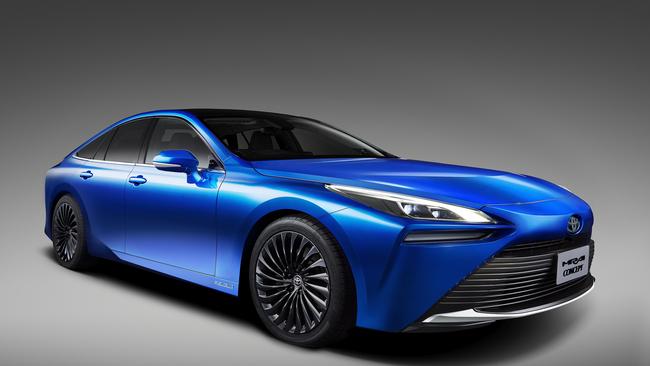Toyota Mirai hydrogen fuel cell car belongs to an exclusive club
Toyota’s hydrogen fuel-cell car is a beauty, powered it seems, by a type of elemental sorcery. But there’s a catch.

I’d like to tell you about what may be the nicest car I’ve ever owned. Not the most exciting, to be absolutely clear. It develops just 135kW and in most respects is a straightforward Toyota saloon, nothing more. But it’s wonderfully insulated from road and wind noise, has a lovely ride and is well built. And although the styling is divisive, I love it, especially the front end. It’s modern and challenging, and seems to be heralding a new way of thinking, as cubism did for art.
I have to accept that, at 58, I’m knocking on a bit. I still thrill to the roar of an Italian V8 positioned behind my shoulders, but that’s an occasional treat. In normal use there’s something deeply satisfying about a car so civilised and silent in operation that I can fully appreciate the noise I now make when I get in.
On a more cerebral level, I like the Toyota Mirai because it’s a hydrogen fuel-cell car. The wheels are driven by an electric motor, but instead of a big rechargeable battery it has a fuel cell that combines hydrogen (from a tank) with oxygen (from the atmosphere) in a frankly occult way that needn’t concern us here. The result: instant electricity when you press the pedal.
The Mirai is refuelled like any other car, from a pump with a nozzle. The only difference is that the hydrogen is delivered at a pressure of 700 bar, which terrifies some people, but the nozzle locks on to the car and communicates with it electronically, to check that all’s well before filling starts. There’s no danger of getting hydrogen all over your trousers.
The process takes a few minutes, and then, as old people say, you can be on your way. Magical, and the enchantment is heightened by the thought that your car is powered by the most abundant but shyest element in the universe; one that hates standing out so much it is always bound up in something else, such as water or fossil fuels or chip fat. But it can be coaxed out, put into my car, and then... sorcery, with only a dribble of pure water emitted as a byproduct.
But here’s the rub. The hydrogen driving club is so exclusive (there are fewer than 200 Mirais in the UK, and the 20 now in Australia are reserved for fleets) that you end up on first-name terms with people simply on the grounds that you own the same type of car (a quick shout-out to Brian, Theo and George). Meanwhile, in recent years the battery electric car has proliferated and next to it, the fuel-cell car looks like a bit of a duffer. The hydrogen is expensive and the cars are very expensive. Elon Musk called them “fool cells”, although he would say that, wouldn’t he?
On the face of it, the only thing going for the Toyota seems to be that it’s quick to refuel. But that means finding a hydrogen filling station, which is a nail-biting exercise in brinkmanship: in the UK we have only 12. [Australia will soon have four]. So until there are more, the fuel-cell car really does look like a non-starter. It has, in fact, been in the doldrums for decades. It seems like a lifetime ago that I drove the hydrogen Honda Clarity for some BBC car show and declared that “batteries will soon be a thing of the past”. No wonder they let me go.
But hang on. There are still issues with batteries. They are bulky and heavy, and they still take too long to charge, even with the likes of Tesla’s superchargers. There are environmental concerns over the materials mined for batteries. And if you want to occasionally make long trips, you might have to buy another car with a conventional engine. By comparison, the upstyled second-generation Mirai you see here claims a range of 600km.
The General Synod of the Church of Electrons will want to point out that most commercial hydrogen is made by reforming fossil fuels, such as gas, which is hardly environmental. But hydrogen can also be “cracked” from water by electrolysis, using renewable energy, in which case efficiency is not such an issue. It then becomes a storable and transportable fuel. Of course the same green energy could be transferred to batteries, but they’d still be batteries.
Here is the impasse that faces the fuel-cell car. It is not a very good solution to decarbonising the car. Battery cars are much better for that. Rather, the fuel-cell car is merely the car element of a much bigger energy vision to decarbonise everything. For that reason I think the car – and the infrastructure to support it – is worth pursuing.
The Sunday Times
TOYOTA MIRAI
ENGINE: Electric motor (135kW/300Nm), rear-wheel drive
RANGE: About 600km
PRICE: About $100,000 (currently fleet-only in Australia)
RATING: ★★★★



To join the conversation, please log in. Don't have an account? Register
Join the conversation, you are commenting as Logout